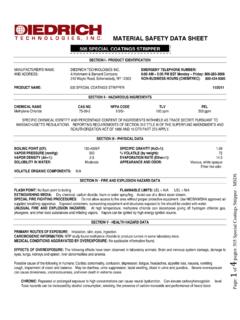Transcription of Neurotransmitters: Their Role Within the Body - - RN.org®
1 neurotransmitters : Their Role in the Body Reviewed May, 2017, Expires May, 2019 Provider Information and Specifics available on our Website Unauthorized Distribution Prohibited 2017 , , , LLC Developed by Meslissa K. Slate, RN, BA, MA Objectives By the end of this educational encounter, the clinician will be able to: 1. Understand how nerve impulses travel along neural pathways 2. Identify common neurotransmitters and Their effect in the body 3. Explain the effect of altered concentrations of specific neurotransmitters upon the system. The purpose of this course is to give an overview of the neurotransmitter system of the human body and increase understanding about how altered neurotransmitter concentrations affect various body organs.
2 Definition of a Neurotransmitter neurotransmitters are types of hormones in the brain that transmit information from one neuron to another. They are made by amino acids. neurotransmitters control major body functions including movement, emotional response, and the physical ability to experience pleasure and pain. The most familiar neurotransmitters , which are thought to play a role in mood regulation, are serotonin, norepinephrine, dopamine, acetylcholine, and GABA. In order to adequately understand the effect of neurotransmitters , we must first understand what occurs in the process of neurotransmission. We will start with an oversimplified version for better understanding and then follow up with a more detailed explaination.
3 A nerve impulse, which is an electrical signal, travels along the neural pathway until it reaches the end. Here the electrical signal is converted to a chemical signal. This area of conversion is called a synapse. The chemical signal is called a neurotransmitter. The nerve impulse then reaches the neuron on the other side, where it once again becomes an electrical signal. The release of a neurotransmitter is triggered by the arrival of a nerve impulse (or action potential) and occurs through an unusually rapid process of cellular secretion, also known as exocytosis. Within the presynaptic nerve terminal, vesicles containing neurotransmitter sit "docked" and ready at the synaptic membrane.
4 neurotransmitters are packaged into vesicles that cluster beneath the membrane on the presynaptic side of a synapse, and released into the synaptic cleft, where they bind to receptors located in the membrane on the postsynaptic side of the synapse. Release of neurotransmitters is most commonly driven by arrival of an action potential at the synapse, but may also be driven by graded electrical potentials. Also, there is often a low level of "baseline" release even in the absence of electrical stimulation. The arriving action potential produces an influx of calcium ions through voltagedependent, calcium-selective ion channels at the down stroke of the action potential (tail current).
5 Calcium ions then trigger a biochemical cascade which results in vesicles releasing Their contents ( neurotransmitters ) to the synaptic cleft Within 180 microseconds of calcium entry. As calcium ions enter into the presynaptic neuron, they bind with the proteins found Within the membranes of the synaptic vesicles that allow the vesicles to "dock." Triggered by the binding of the calcium ions, the synaptic vesicle proteins begin to move apart, resulting in the creation of a fusion pore. The presence of the pore allows for the release of neurotransmitter into the synapse. The membrane added by this fusion is later retrieved by endocytosis and recycled for the formation of fresh neurotransmitter-filled vesicles.
6 Receptor Binding Receptors on the opposite side of the synaptic gap bind neurotransmitter molecules and respond by opening nearby ion channels in the postsynaptic cell membrane, causing ions to rush in or out and changing the local transmembrane potential of the cell. Often the lock and key hypothesis is used to illustrate the interaction between a neurotransmitter and its receptor. The key (the neurotransmitter) can only unlock (activate) a lock (the receptor) if it fits perfectly into the keyhole (neurotransmitter binding site) of the lock. Receptors and auto receptors are sensitive to the neurotransmitter concentration in the synaptic cleft. Auto receptors regulate the release of the neurotransmitter from the presynaptic neuron when these presynaptic receptors are fully occupied, neurotransmitter production is stopped.
7 Over sensitivity of auto receptors may be implicated in the development of depression. Almost every neurotransmitter can bind to more than one type of receptor, and each neurotransmitter can initiate different signals at the postsynaptic neuron. This all adds to the complexity of chemical signaling. Binding of a neurotransmitter to its receptor on the postsynaptic membrane can activate channels in the postsynaptic neuron resulting in a change in the membrane potential. This initiates an excitatory or inhibitory postsynaptic potential that changes the excitability of the postsynaptic neuron and initiates an action potential. The resulting change in voltage is called a postsynaptic potential.
8 In general, the result is excitatory, in the case of depolarizing currents, or inhibitory in the case of hyperpolarizing currents. Whether a synapse is excitatory or inhibitory depends on what type(s) of ion channel conduct the postsynaptic current display(s), which in turn is a function of the type of receptors and neurotransmitter employed at the synapse. In this way, the electrical signal or impulse is transmitted down the neuronal pathway. Once the action potential is initiated, the transmitter must then be rapidly removed from the synaptic cleft, to enable the postsynaptic cell to engage in another cycle of signal generation. The release of a neurotransmitter from its nerve terminal is not only dependent upon the passage of an action potential, but also on the intersynaptic concentration of the transmitter.
9 This is known as presynaptic inhibition. At certain synapses, such as noradrenergic, GABA ergic, dopaminergic and serotonergic synapses, the release of the neurotransmitter may be reduced by the presence of high concentrations of the transmitter in the synaptic cleft. The release of a neurotransmitter can also be affected by a variety of other neurotransmitters ; for example, stimulation of serotonin receptors on noradrenergic terminals can lead to an enhanced release of noradrenaline. Such receptors are termed heteroceptors. Neurons and synapses occur in specific patterns in the brain, giving rise to complex neuronal circuits. This results in the specialization of different regions of the brain for different functions and allows us to integrate information such as sound, vision, smell, taste and touch.
10 Each neurotransmitter is made by a small number of neurons whose cell bodies are clustered in specific areas of the brain. For example, noradrenaline is synthesized mainly by neurons in the brainstem, specifically in the locus coeruleus, which is situated in the pons; the cell bodies of the dopamine neurons are clustered in a few brain regions, most importantly those deep Within the midbrain. However, the axons of these neurons extend throughout the brain and influence almost the entire organ. Termination After a neurotransmitter molecule binds to a receptor molecule, it does not stay bound forever: sooner or later it is shaken loose by random temperature-related jiggling.

















